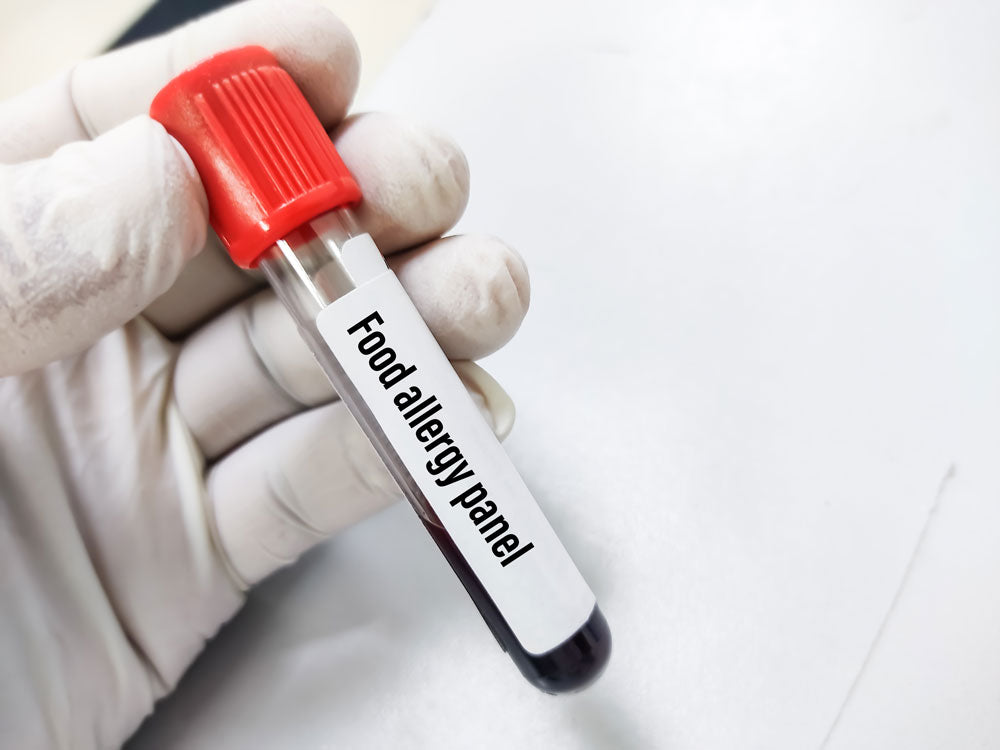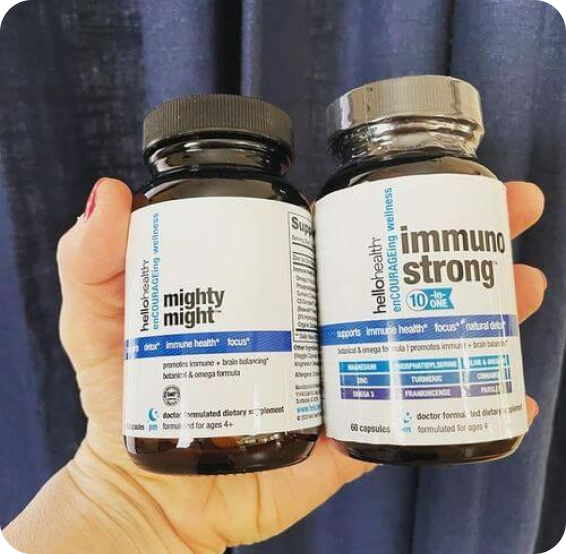hellohealth
Food Allergy Profile
Food Allergy Profile
Brief Description: The Food Allergy Profile test is a specialized laboratory assay designed to assess an individual's immune response to specific foods. This comprehensive panel aids in the identification of allergens that could trigger adverse reactions in the body.
Also Known As: Food Allergy Panel. Food Allergy Test
Collection Method: Blood Draw
Specimen Type: Serum
Test Preparation: No preparation required

Customer Reviews (% reviewsData.profile_link_title %)
0 Review
When is a Food Allergy test ordered?
When a person exhibits symptoms or signs that point to an allergy to one or more substances, one or more tests for the allergen-specific IgE antibodies are typically requested. Some warning signs and symptoms include:
- Hives
- Dermatitis
- Eczema
- Angry red eyes
- nasal congestion, sneezing, and coughing
- Asthma
- tongue tingling and scratching
- stomach aches, nausea, or diarrhea
On occasion, a test may also be requested to assess the efficacy of immunotherapy or identify whether a child has outgrown an allergy.
What does a Food Allergy blood test check for?
A family of antibodies called immunoglobulin E is connected to allergic responses. Normally, blood only contains very trace levels of it. In order to identify an allergy to a specific substance, this test quantifies the level of allergen-specific IgE in the blood.
The immune system of the body, which serves as its line of defense against “intruders,” includes the antibody IgE. A person who is predisposed to allergies becomes sensitized the first time they are exposed to a potential allergen, such as food, grass, or animal dander. When a person is exposed to a potential allergen, their body reacts by producing a particular IgE antibody that attaches to basophils in the circulation as well as specialized mast cells in their skin, respiratory system, and gastrointestinal tract. The allergic reaction starts at the location of the next exposure when these associated IgE antibodies recognize the allergen and stimulate the mast and basophil cells to release histamine and other chemicals in response.
Honeybee against bumblebee, egg white versus egg yolk, and gigantic ragweed versus western ragweed are just a few examples of the allergen-specific IgE antibody tests that have been conducted. These tests can be grouped together as food panels or regional weed, grass, and mold panels, for example. Alternately, the medical professional may choose and choose from a lengthy list of specific allergens that are thought to be the source of a person’s allergies.
The RAST radioallergosorbent test, which was once the standard procedure for blood testing, has been replaced by more recent IgE-specific immunoassay techniques.
This specific Food Allergy Profile tests for the following IgE antibodies:
- Almond (f20)
- Cashew Nut (f202)
- Codfish (f3)
- Cow’s Milk (f2)
- Egg White (f1)
- Hazelnut (f17)
- Peanut (f13)
- Salmon (f41)
- Scallop (f338)
- Sesame Seed (f10)
- Shrimp (f24)
- Soybean (f14)
- Tuna (f40)
- Walnut (f256)
- Wheat (f4)
Lab tests often ordered with a Food Allergy test:
When a Food Allergy Profile is ordered, it's often part of a broader evaluation of allergic symptoms or immune responses. Here are some tests and assessments commonly ordered alongside it:
These tests and assessments, when ordered alongside a Food Allergy Profile, provide a comprehensive evaluation of potential food allergies and allergic responses. They help in accurately diagnosing food allergies, differentiating them from food intolerances and other conditions, and guiding appropriate dietary and medical management. The specific combination of tests will depend on the individual’s symptoms, dietary history, and clinical presentation.
Conditions where a Food Allergy test is recommended:
The Food Allergy Profile test is relevant for evaluating and diagnosing various conditions, including:
- Food Allergies: Suspected allergies to specific foods, such as nuts, dairy, eggs, and wheat, can be confirmed or ruled out through this test.
- Food Intolerances: The test aids in identifying immune responses to foods that may trigger non-IgE-mediated reactions, such as food intolerances.
How does my health care provider use a Food Allergy test?
When a person exhibits acute or persistent allergy-like symptoms, a blood test called the allergen-specific IgE antibody test can assist determine whether they are allergic to a particular drug or substances. This is especially true if additional family members are known to have allergies and if symptoms are persistent and seem to be linked to triggers, such as exposure to specific foods or settings.
By exposing a person to various substances while being closely monitored by a medical professional, several sorts of allergy testing can be carried out. However, some skin disorders, such as severe dermatitis or eczema, as well as some drugs, such as histamines and some anti-depressants, can impair the effectiveness of these tests. There is also a chance for severe reactions, including ones that could be fatal, like anaphylaxis, with some testing. The allergen-specific IgE antibody test may be requested as an alternative in these circumstances because it is carried out on a blood sample and has no effect on the person being examined.
The allergen-specific IgE antibody test can help determine whether a child has outgrown an allergy or whether immunotherapy is working. The degree of IgE present does not correspond to the intensity of an allergic reaction, and someone who has outgrown an allergy may continue to have positive IgE for many years thereafter, therefore it can only be used in a generic sense.
What do my Food Allergy test results mean?
Blood tests for allergies must be read carefully. There is a slight possibility that a person does in fact have an allergy even if an IgE test is negative. A person may or may not ever experience an actual physical allergic reaction when exposed to that substance if the specific IgE test is positive.
Negative findings suggest that a person is most likely not allergic, as defined by an IgE-mediated reaction to the particular allergens tested.
A high allergen-specific IgE result suggests that the subject is probably allergic. The quantity of particular IgE present, however, does not always indicate how severe a reaction can be. To confirm an allergy diagnosis, a person's clinical background and additional medically-supervised allergy testing may be required.
Most Common Questions About the Food Allergy Profile test:
Purpose and Indications for the Food Allergy Profile Test
Why is the Food Allergy Profile Test important?
The Food Allergy Profile Test is pivotal in identifying potential food allergens that an individual might be sensitive to. This information can guide dietary choices and help prevent allergic reactions.
When should someone consider taking the Food Allergy Profile Test?
Individuals who experience symptoms like hives, itching, swelling, digestive issues, or more severe reactions like anaphylaxis after consuming certain foods should consider this test. Additionally, it can be beneficial for those with a family history of food allergies or other atopic conditions like asthma or eczema.
Interpreting the Results
What do the results of the Food Allergy Profile Test indicate?
The results usually measure the amount of specific IgE antibodies to particular foods. Elevated levels of these antibodies suggest a potential allergy to that food. However, it's essential to correlate lab results with clinical symptoms, as not everyone with elevated IgE will have clinical allergies.
Does a negative result on the Food Allergy Profile Test rule out food allergies?
No, a negative result reduces the likelihood of a food allergy but does not eliminate the possibility entirely. Some individuals might have non-IgE mediated food allergies, which this test does not detect.
Conditions Influencing the Test
Can other medical conditions impact the Food Allergy Profile Test results?
Yes, conditions like parasitic infections or some cancers can lead to elevated IgE levels, which might be misinterpreted as allergies.
Dietary Influence and Recommendations
Does recent exposure to a potential allergen affect the Food Allergy Profile Test results?
Yes, recent exposure can lead to elevated specific IgE levels. It's recommended to discuss any recent allergic reactions or exposures with the healthcare provider.
If a food allergen is identified, what are the dietary recommendations?
Typically, it's recommended to avoid the identified allergen completely. An allergist or nutritionist can provide guidance on alternative foods and reading food labels to ensure the allergen isn't consumed inadvertently.
Follow-up and Treatment
What should be the next step after a positive Food Allergy Profile Test result?
A positive result should lead to a consultation with an allergist. They can provide guidance on avoidance, potential treatments, and might conduct further tests, such as food challenges, to confirm the allergy.
Are there treatments available for food allergies identified through the Food Allergy Profile Test?
Currently, the primary treatment for food allergies is avoidance. However, there are ongoing research and trials on treatments like oral immunotherapy. Epinephrine auto-injectors are prescribed for those at risk of severe reactions.
We advise having your results reviewed by a licensed medical healthcare professional for proper interpretation of your results.
*Important Information on Lab Test Processing Times: Ulta Lab Tests is committed to informing you about the processing times for your lab tests processed through a national lab. Please note that the estimated processing time for each test, indicated in business days, is based on data from the past 30 days across the 13 laboratories for each test. These estimates are intended to serve as a guide and are not guarantees. Factors such as laboratory workload, weather conditions, holidays, and the need for additional testing or maintenance can influence actual processing times. We aim to offer estimates to help you plan accordingly. Please understand that these times may vary, and processing times are not guaranteed. Thank you for choosing Ulta Lab Tests for your laboratory needs.
The Food Allergy Profile test contains 1 test with 15 biomarkers.
The 4 Ways to View Your Results
-

Results Graphed Dynamically
This viewing method allows you to see your test results in a dynamic graph format, visually tracking changes over time so that you can better understand your health trends.
-

Results by Category
This method organizes your test results by category, making it easier to navigate and understand them based on different areas of health or body systems.
-

Functional Reference Ranges
With functional reference ranges, you can view your test results in the context of optimal health ranges rather than just standard laboratory ranges. This can provide a more in-depth perspective on your health status.
-

Results Report
This is a traditional lab report format provided by the lab, offering you a familiar layout of your results that is often used for sharing with healthcare providers.
 Free shipping Over $100+
Free shipping Over $100+









